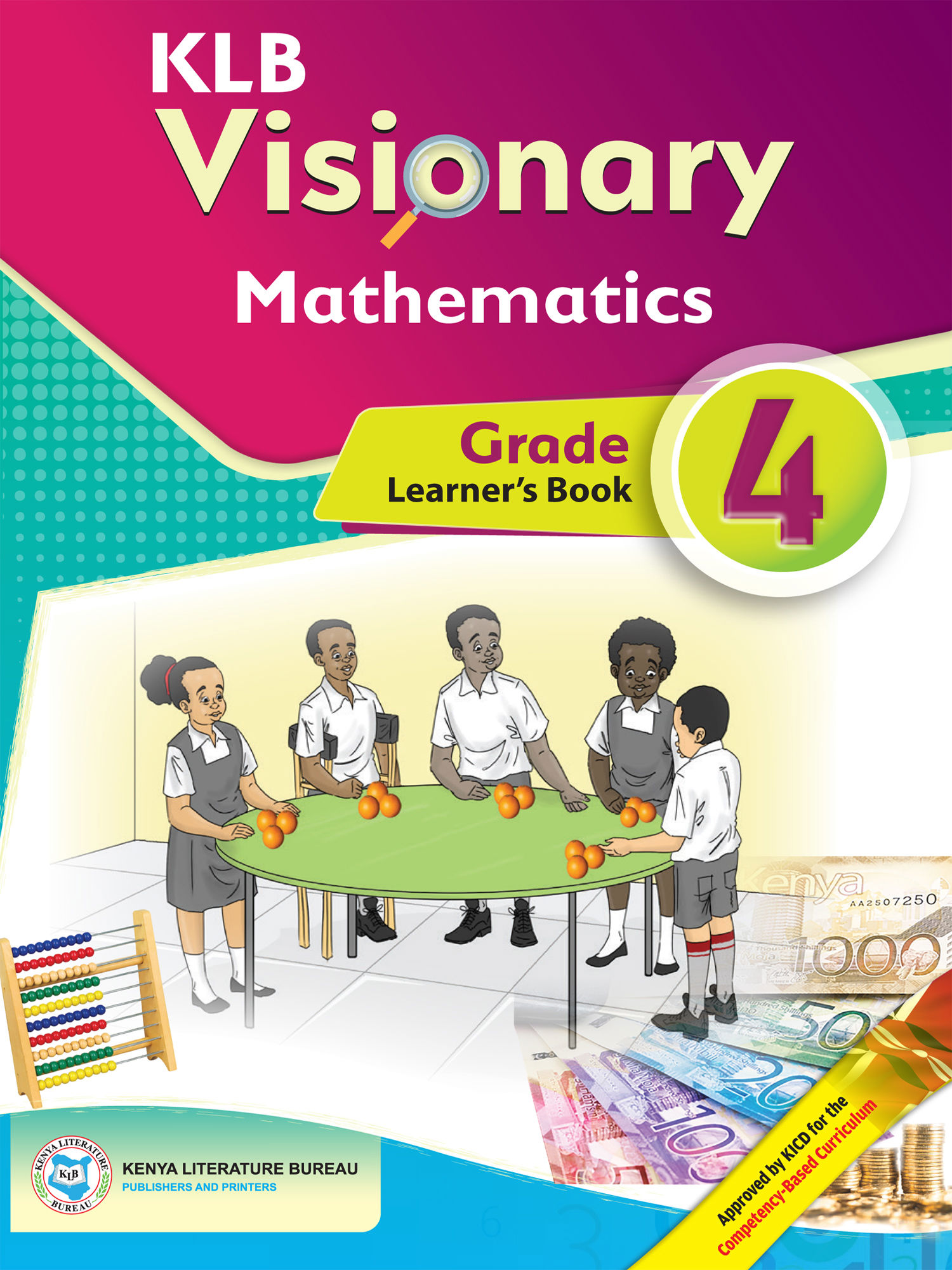
Authors
Obadiah Kiburi, Samuel Irumbi, Zipporah N. Muli, Francis MwangiExercises kit’s authors
Obadiah Kiburi, Samuel Irumbi, Zipporah N. Muli, Francis MwangiPublisher
Kenya Literature Bureau
Included in packages

-
The study kit contains 113 chapters and 833 exercises of which 638 are in the chapters and 195 in the task exercises.
-
Authors
Obadiah Kiburi, Samuel Irumbi, Zipporah N. Muli, Francis Mwangi -
Exercises kit’s authors
Obadiah Kiburi, Samuel Irumbi, Zipporah N. Muli, Francis Mwangi -
Subject
Mathematics -
Grade
Grade 4 -
Kit's language
English -
Publisher
Kenya Literature Bureau -
Included in packages
1. Numbers – Whole numbers
2. Numbers – Addition
3. Numbers – Subtraction
4. Numbers – Multiplication
5. Numbers – Division
6. Numbers – Fractions
7. Numbers – Decimals
Lead |
Chapter |
|---|---|
| 7.1. | Writing tenths and hundredths |
| 7.2. | Writing tenths using decimal notation |
| 7.3. | Writing hundredths using decimal notation |
| 7.4. | Place value of decimals: tenths |
| 7.5. | Place value of decimals: hundredths |
| 7.6. | Ordering tenths |
| 7.7. | Ordering hundredths |
8. Measurement – Length
Lead |
Chapter |
|---|---|
| 8.1. | Measuring length |
| 8.2. | Measuring lines |
| 8.3. | Estimate and actual length |
| 8.4. | Converting units of length |
| 8.5. | Perimeter |
| 8.6. | Addition of units of length |
| 8.7. | Subtraction of units of length |
| 8.8. | Multiplication of units of length |
| 8.9. | Division of units of length |
9. Measurement – Area
Lead |
Chapter |
|---|---|
| 9.1. | Area of surfaces |
| 9.2. | Area of squares and rectangles by counting unit squares |
| 9.3. | Finding area by multiplying rows and columns |
| 9.4. | Area of square and rectangle |
10. Measurement – Mass
Lead |
Chapter |
|---|---|
| 10.1. | Measuring mass using 1 kg and ½ kg masses |
| 10.2. | Measuring mass using ¼ kg masses |
| 10.3. | Mass in ½ kg and ¼ kg |
| 10.4. | Addition of mass |
| 10.5. | Subtraction of mass |
11. Measurement – Volume
Lead |
Chapter |
|---|---|
| 11.1. | Cube and cuboid |
| 11.2. | Cube |
| 11.3. | Cuboid |
12. Measurement – Capacity
Lead |
Chapter |
|---|---|
| 12.1. | Capacity in litres and ½ litres |
| 12.2. | Capacity in ¼ litres |
| 12.3. | Capacity in ½ litres and ¼ litres |
| 12.4. | Addition of capacity |
| 12.5. | Subtraction of capacity |
13. Measurement – Time
Lead |
Chapter |
|---|---|
| 13.1. | Time in a.m. and p.m. |
| 13.2. | Estimating time |
| 13.3. | Converting hours to minutes and vice versa |
| 13.4. | Converting days to hours and vice versa |
| 13.5. | Converting weeks to days and vice versa |
| 13.6. | Measuring time during events |
| 13.7. | Addition of units of time |
| 13.8. | Subtraction of units of time |
14. Measurement – Money
Lead |
Chapter |
|---|---|
| 14.1. | Conversion of units of money |
| 14.2. | Change |
| 14.3. | Balance |
| 14.4. | Needs and wants |
| 14.5. | Savings |
| 14.6. | Addition of money |
| 14.7. | Subtraction of money |
| 14.8. | County Government money |
15. Geometry – Position and Direction
Lead |
Chapter |
|---|---|
| 15.1. | Clockwise and anti‑clockwise turns |
| 15.2. | A quarter, half and full turn |
16. Geometry – Angles
Lead |
Chapter |
|---|---|
| 16.1. | An angle |
| 16.2. | Types of angles |
| 16.3. | Comparing angles |
17. Geometry – Shapes
Lead |
Chapter |
|---|---|
| 17.1. | Shapes in our environment |
| 17.2. | Lines of symmetry |
| 17.3. | Properties of square and rectangle |
| 17.4. | Properties of triangles |
| 17.5. | Making patterns |
18. Data Handling
Lead |
Chapter |
|---|---|
| 18.1. | Collecting and organising data |
| 18.2. | Tally marks |
| 18.3. | Showing data |
| 18.4. | Interpretation (1) |
| 18.5. | Interpretation (2) |
19. Algebra
Lead |
Chapter |
|---|---|
| 19.1. | Use of letters |
| 19.2. | Forming algebraic expressions: addition |
| 19.3. | Forming algebraic expressions: subtraction |
| 19.4. | Forming algebraic expressions: multiplication |
| 19.5. | Forming algebraic expressions: division |
| 19.6. | Simplifying |
